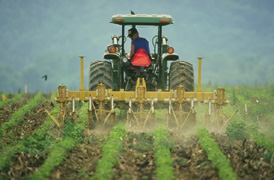|

Soybeans being
cultivated for weed control. Click the image for more information about
it.
|
Grain-Forage Crop Rotations Seen Boosting Soil
Quality
By Luis
Pons April 14, 2006
Farmers looking to maintain soil quality may want to get back to
planting extended rotations of grain and forage crops. So indicates an
Agricultural Research Service (ARS)-led
study released today.
The study—headed by soil scientist
Douglas
Karlen of ARS'
National
Soil Tilth Laboratory in Ames, Iowa—found that crop rotations covering
a minimum of five years, including at least three years of forage crops
interspersed with corn and soybean, resulted in higher soil-quality ratings
than either continuous corn or a two-year corn-soybean sequence.
The longer-term rotations also had an additional benefit: They were
more profitable than continuous corn production.
ARS is the U.S. Department of Agriculture's (USDA's) chief scientific research agency.
Collaborators in the study included scientists with the Soil Quality
Team of USDA's Natural Resources
Conservation Service and Iowa State
University.
According to Karlen, the study shows the need to create new markets
and new uses for forage crops so that producers will have financial incentives
to diversify their crop rotations.
Larger farm size, specialization, and separation of agricultural crop
and animal enterprises—along with pressure to maximize short-term profit
throughout the nation's corn and soybean belt—have decreased
implementation of long-term crop rotations over the past 50 years. The result,
according to Karlen, has been crop rotations that leave land bare for nearly
six months each year, spurring organic-matter decomposition and erosion if the
soils are tilled.
The researchers collected soil samples from three long-term crop
rotation studies and one long-term organic study in Iowa and Wisconsin. They
analyzed the samples for several physical, chemical and biological soil-quality
indicators that were then used to develop an overall soil-quality index (SQI).
Soil samples from extended rotations that included at least three
years of forage crops such as alfalfa or oats scored the highest SQI values.
The lowest SQI values were associated with continuous corn.
This study will appear in the May/June 2006 issue of Agronomy
Journal. It is scheduled to be posted on the journal's website today at
http://agron.scijournals.org/.